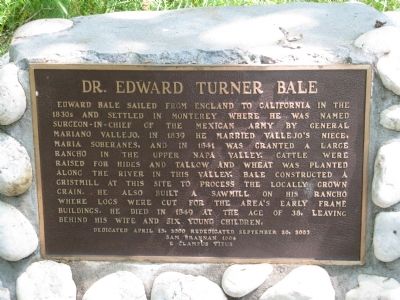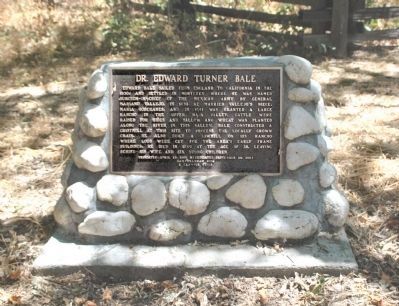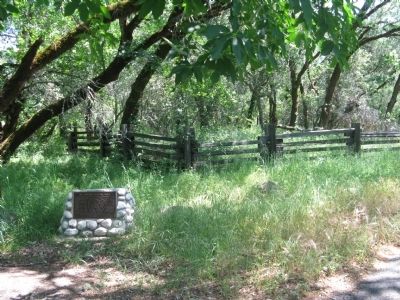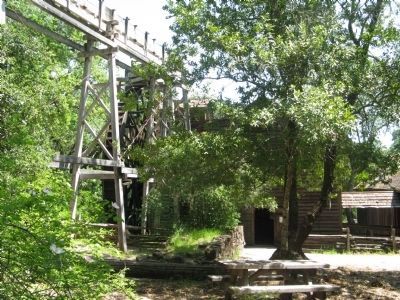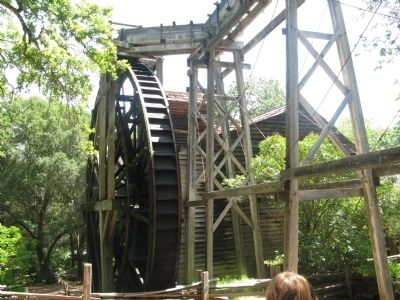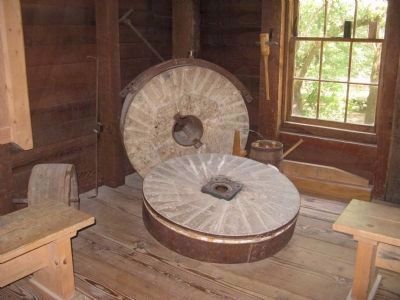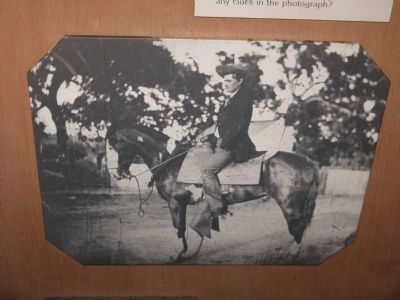Calistoga in Napa County, California — The American West (Pacific Coastal)
Dr. Edward Turner Bale
Sam Brannan 1004
E Clampus Vitus
Erected 2000 by Sam Brannan Chapter 1004 E Clampus Vitus. (Marker Number 359.)
Topics and series. This historical marker is listed in these topic lists: Industry & Commerce • Settlements & Settlers • War, Mexican-American. In addition, it is included in the California Historical Landmarks, and the E Clampus Vitus series lists. A significant historical date for this entry is April 15, 1830.
Location. 38° 32.4′ N, 122° 30.598′ W. Marker is in Calistoga, California, in Napa County. Marker can be reached from Saint Helena Highway (State Highway 29/128). Marker is located at the parking area of the Bale Grist Mill State Historic Park, .4 of a mile from highway, at the beginning of the trail to the mill. Touch for map. Marker is at or near this postal address: 3801 Saint Helena Highway, Calistoga CA 94515, United States of America. Touch for directions.
Other nearby markers. At least 8 other markers are within 2 miles of this marker, measured as the crow flies. Bale Grist Mill (within shouting distance of this marker); The White Church (approx. 0.7 miles away); Reason P. Tucker (approx. 1.1 miles away); Schramsberg (approx. 1½ miles away); Larkmead Winery / Kornell Cellars (approx. 1½ miles away); Charles Krug Winery (approx. 1.9 miles away); Cesare Mondavi 1883 – 1959 (approx. 1.9 miles away); Charles Krug 1825 - 1892 (approx. 1.9 miles away). Touch for a list and map of all markers in Calistoga.
Regarding Dr. Edward Turner Bale. This site was designated as California Registered Historical Landmark No.359 on October 9, 1939.
Also see . . . California State Park website giving information on the park. (Submitted on May 4, 2009.)
Additional commentary.
1. Additional Information Regarding the Marker Dedication
Johnny Lind was Noble Grand Hunbug when this plaque was erected. The monument was constructed by Johnny
Lind, Carl Schoelles, and Loren Wilson. Plaque wording by Loren A. Wilson.
— Submitted April 15, 2012, by Loren Wilson of Sebastopol, California.
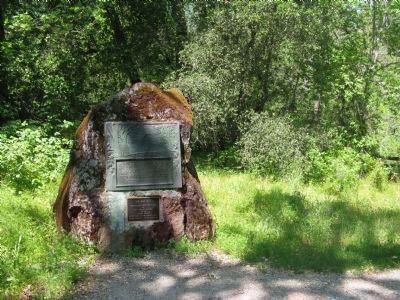
Photographed By Syd Whittle, April 26, 2009
4. A Second Marker at the Bale Grist Mill State Historic Park
These markers are located about half way between parking area and the mill.
Upper Marker:
This historic grist mill known as the “Bale Mill” was erected by Dr. E.T. Bale, Grantee Carne Human Rancho, in 1846. The mill with its surrounding land was deeded to the Native Sons of the Golden West by Mrs. W.W. Lyman. Restored through the efforts of the Native Son Parlors of Napa County. Under the leadership of past Grand President Bismark Bruck, a grandson of Dr. Bale, and by the Historic Landmarks Committee of the Native Sons of the Golden West. The restored mill was dedicated June 21, 1925.
Tablet placed by Historic Landmarks Committee,
Native Sons of the Golden West
Lower Marker:
OLD BALE MILL
Rededicated October 1, 1988
By
Napa Valley Parlors
and the
Grand Parlor
Native Sons of the Golden West
Frank Compani, President
Click for more information.
Upper Marker:
This historic grist mill known as the “Bale Mill” was erected by Dr. E.T. Bale, Grantee Carne Human Rancho, in 1846. The mill with its surrounding land was deeded to the Native Sons of the Golden West by Mrs. W.W. Lyman. Restored through the efforts of the Native Son Parlors of Napa County. Under the leadership of past Grand President Bismark Bruck, a grandson of Dr. Bale, and by the Historic Landmarks Committee of the Native Sons of the Golden West. The restored mill was dedicated June 21, 1925.
Native Sons of the Golden West
Lower Marker:
Rededicated October 1, 1988
By
Napa Valley Parlors
and the
Grand Parlor
Native Sons of the Golden West
Frank Compani, President
Click for more information.
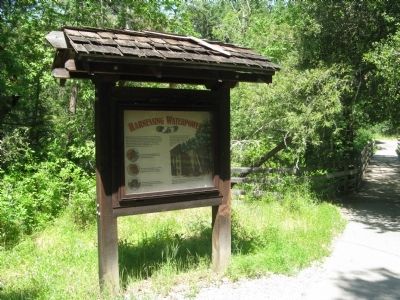
Photographed By Syd Whittle, April 26, 2009
5. Harnessing Waterpower
An Interpretive Panel on the trail to the mill.
Waterwheels have been used for some 2,000 years. Such early mechanical inventions were an important way for people of the past to use available resources. These wheels provided tireless and consistent power for many kids of milling machines. Their basic designs changed little, and millers used the type best suited to each mill condition.
--Horizontal waterwheels were driven by water diverted from fast-moving streams.
--Breasted waterwheels received the water’s impact at about midlevel of the vertical height.
--Undershot wheels turned as fast-moving water hit the lowest part of the wheel.
The Bale Mill’s overshot wheel is a type often used where the water source was high. Power came from the weight of falling water rather than its force of flow.
Water from Mill Creek, diverted by upstream dams, was delivered by ditches and flumes to operate the Bale Mill’s waterwheel.
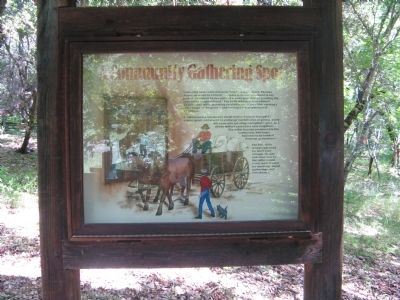
Photographed By Syd Whittle, April 26, 2009
6. Community Gathering Spot
Interpretive panel on the trail to the mill.
Grist mills were central to early American agriculture. Thomas Jefferson wrote to a friend, “…there is no neighborhood in any part of the United States without a water grist mill for grinding the corn of the neighborhood.” The 1840 census showed 23,661 small mills operating on a toll basis – the miller earning a percentage of the grain – and serving a U.S. population of 17 million.
A mill became a community social center. Farmers brought in grains (grist) and stayed to exchange market news of gossip, Good will came with grinding a neighbor’s grist, and all the miller’s customers were neighbors. The miller became prominent to the community, building a business to be handed down for generations.
The Bale Mill’s granary was used for more than storage. Its size and closeness to the valley’s main roads made it ideal for meetings, social gatherings, and even dances.
Grist mills were central to early American agriculture. Thomas Jefferson wrote to a friend, “…there is no neighborhood in any part of the United States without a water grist mill for grinding the corn of the neighborhood.” The 1840 census showed 23,661 small mills operating on a toll basis – the miller earning a percentage of the grain – and serving a U.S. population of 17 million.
A mill became a community social center. Farmers brought in grains (grist) and stayed to exchange market news of gossip, Good will came with grinding a neighbor’s grist, and all the miller’s customers were neighbors. The miller became prominent to the community, building a business to be handed down for generations.
The Bale Mill’s granary was used for more than storage. Its size and closeness to the valley’s main roads made it ideal for meetings, social gatherings, and even dances.
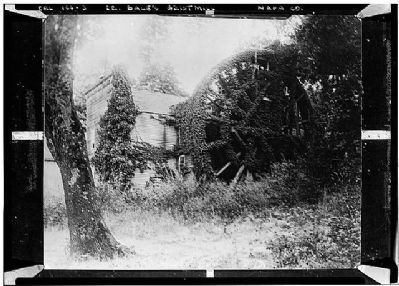
Wm. H. Knowles Collection San Francisco, California, circa 1930
7. Bale's Grist Mill
Historic American Buildings Survey (Library of Congress)
HABS CAL,28-CAL.V,1-
Click for more information.
Click for more information.
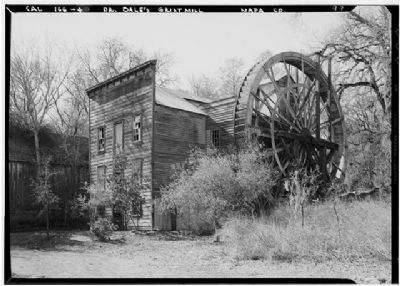
Photographed By Robert W. Kerrigan, Photographer, February 18, 1937
8. Bale's Grist Mill
Historic American Buildings Survey (Library of Congress)
HABS CAL,28-CAL.V,1-
Click for more information.
Click for more information.
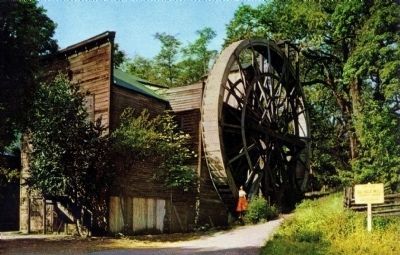
Photographed By Jack W. Coburn,Martinez, Ca.
12. The Old Bale Mill
Description on Postcard:
This relic of pioneer days is located between St.Helena and Calistoga. Built in 1846 by Dr. Edward T.Bale,it furnished flour to the residents of the Napa Valley for over thirty-five years. Still standing with its overshot water wheel of 45 feet now idle,this historic building is a landmark for tourists.
This relic of pioneer days is located between St.Helena and Calistoga. Built in 1846 by Dr. Edward T.Bale,it furnished flour to the residents of the Napa Valley for over thirty-five years. Still standing with its overshot water wheel of 45 feet now idle,this historic building is a landmark for tourists.
Credits. This page was last revised on September 19, 2020. It was originally submitted on May 4, 2009, by Syd Whittle of Mesa, Arizona. This page has been viewed 3,088 times since then and 21 times this year. Photos: 1. submitted on May 4, 2009, by Syd Whittle of Mesa, Arizona. 2. submitted on April 15, 2012, by Loren Wilson of Sebastopol, California. 3, 4, 5, 6, 7, 8, 9, 10, 11, 12. submitted on May 4, 2009, by Syd Whittle of Mesa, Arizona. 13. submitted on May 6, 2009, by Syd Whittle of Mesa, Arizona.
